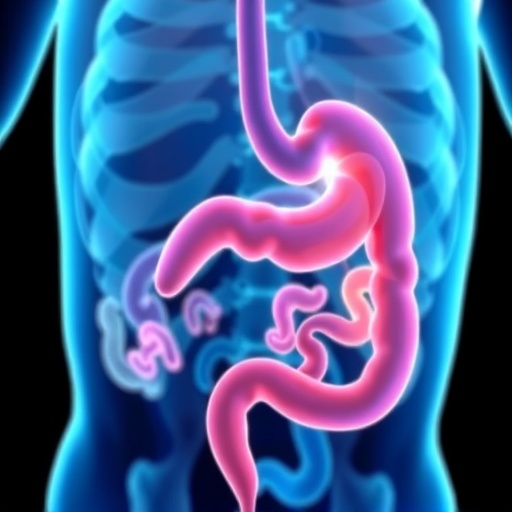
In the realm of gastric cancer treatment, robotic radical surgery has emerged as a cutting-edge approach, promising precision and minimal invasiveness. However, patient outcomes following such advanced procedures remain heavily influenced by underlying physiological conditions. A recent population-based retrospective cohort study published in BMC Cancer has shed light on two critical factors—low skeletal muscle mass and diminished muscle quality—which significantly shape the clinical trajectories of patients undergoing robotic radical gastric cancer surgery.
Sarcopenia, characterized by a marked reduction in skeletal muscle index (SMI), and myosteatosis, or the infiltration of fat within muscle tissue leading to decreased skeletal muscle radiodensity (SMD), have long been implicated in poorer prognoses for cancer patients. Yet, the explicit impact of these muscle deficiencies specifically in the context of robotic gastric cancer surgery had been an unresolved question until now.
This comprehensive study analyzed a cohort of 381 patients treated between December 2019 and October 2022, all of whom underwent robotic radical surgery for gastric cancer. Utilizing preoperative computed tomography (CT) scans, researchers meticulously quantified skeletal muscle mass and radiodensity, thus enabling a nuanced assessment of sarcopenia and myosteatosis with non-invasive imaging biomarkers.
Intriguingly, the demographic profile revealed a mean patient age of 58.5 years, with males constituting nearly 70% of the group. The robust sample size and well-defined patient characteristics bolster the validity of the analytical outcomes, offering a window into real-world implications for this specific surgical cohort.
The findings were striking. Patients with either low SMI or low SMD exhibited significantly higher odds of postoperative complications compared to their counterparts with normal muscle metrics. Specifically, the odds ratios associated with these muscle deficiencies ranged from approximately 2.5 to over 3, underscoring a strong independent relationship regardless of other confounding clinical factors.
Further compounding the risk, these muscle impairments were linked to alarming rates of unplanned admissions to intensive care units (ICU) and elevated 30-day mortality rates. Such associations highlight the critical systemic vulnerabilities that low skeletal muscle mass and quality confer on patients entering complex surgical regimens.
Moreover, when sarcopenia and myosteatosis coexisted within a patient, the detrimental effects appeared to amplify synergistically. The combined presence exponentially increased the odds of severe complications and drastically worsened short-term mortality metrics, with one particular statistic indicating nearly a tenfold increase in 30-day mortality risk compared to patients with neither condition.
Beyond the immediate postoperative period, the study also tracked longitudinal survival outcomes. A concurrent deficit in both muscle mass and radiodensity corresponded with a threefold greater hazard of mortality over the follow-up timeline, emphasizing the lasting prognostic weight of these physiological parameters.
These results hold profound implications for preoperative risk stratification. The incorporation of muscle mass and radiodensity assessments via routine CT imaging could serve as an invaluable adjunct in surgical planning, enabling the identification of patients at elevated risk for adverse events. Such stratification might prompt the development of tailored perioperative care protocols, potentially modulating outcomes through nutritional support, physical rehabilitation, or pharmacologic interventions before surgery.
Technically, the study’s methodology leveraged advanced image analysis to extract quantifiable metrics of skeletal muscle morphology—parameters not traditionally emphasized in oncologic surgical contexts. This novel application underscores the versatility of CT imaging as a dual-purpose tool, simultaneously facilitating tumor staging and prognostic musculoskeletal evaluation.
The multivariable regression and propensity score matching techniques employed minimized biases from confounding variables, reinforcing the causal inference that low skeletal muscle mass and radiodensity independently contribute to poor surgical outcomes. These rigorous analytic strategies lend credibility to the observed associations and support their translation into clinical practice.
Despite the promise of robotic surgical technologies, this investigation reminds the medical community that optimal patient outcomes demand holistic preoperative consideration. It is insufficient to focus solely on the technical excellence of the procedure; instead, a broader biological perspective encompassing the patient’s musculoskeletal health is essential.
Looking ahead, these insights open avenues for interventional studies aimed at reversing or mitigating sarcopenia and myosteatosis prior to surgery. Such prehabilitation strategies could revolutionize the perioperative care landscape for gastric cancer patients, marrying technological innovation with physiologic optimization.
The study also raises questions about the underlying pathophysiological mechanisms linking muscle degradation to surgical vulnerability. Chronic inflammation, metabolic derangements, and impaired immune competence are probable contributors worthy of further exploration. Understanding these pathways might yield novel therapeutic targets beyond mere muscle mass restoration.
Importantly, this research enriches the discourse on personalized medicine in oncology, highlighting that surgical candidacy and expected recovery are not solely defined by tumor factors but also by patient-specific systemic health variables. Tailoring interventions to address muscular deficits could represent a paradigm shift in patient-oriented cancer care.
In sum, the confluence of low skeletal muscle mass and radiodensity serves as a powerful prognostic indicator in patients undergoing robotic radical gastric cancer surgery, influencing an array of outcomes from complication rates to mortality and survival. By integrating routine muscle assessment into clinical workflows, healthcare providers stand to markedly improve risk prediction and therapeutic decision-making.
As robotic surgery continues to evolve and permeate oncologic treatment algorithms, studies like this one emphasize the indispensability of holistic patient evaluations. The fusion of technological prowess with nuanced biological appraisal promises the next frontier in elevating surgical oncology outcomes worldwide.
Subject of Research: Low skeletal muscle mass (sarcopenia) and skeletal muscle radiodensity (myosteatosis) as prognostic factors influencing clinical outcomes in robotic radical gastric cancer surgery.
Article Title: Association of low skeletal muscle mass and radiodensity with clinical outcomes in patients undergoing robotic radical gastric cancer surgery: a population-based retrospective cohort study
Article References:
Guo, H., Chen, S., Zheng, T. et al. Association of low skeletal muscle mass and radiodensity with clinical outcomes in patients undergoing robotic radical gastric cancer surgery: a population-based retrospective cohort study. BMC Cancer 25, 741 (2025). https://doi.org/10.1186/s12885-025-14156-2
Image Credits: Scienmag.com
DOI: https://doi.org/10.1186/s12885-025-14156-2
Tags: demographics of gastric cancer patientslow muscle mass impact on cancer surgerymuscle quality and surgical recoverymyosteatosis in surgical patientsnon-invasive assessment of muscle masspopulation-based cohort study on gastric cancerpostoperative outcomes in gastric cancer surgerypreoperative imaging biomarkers for surgeryrobotic gastric surgery outcomesrobotic surgery advancements in oncologysarcopenia and gastric cancer treatmentskeletal muscle index and cancer prognosis





